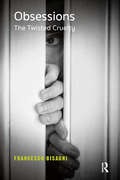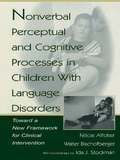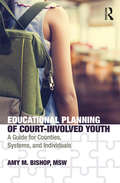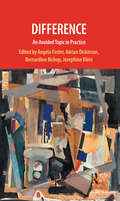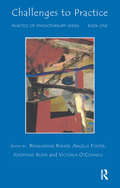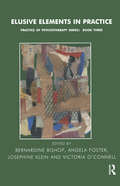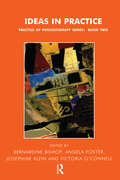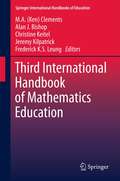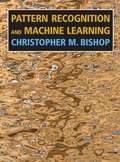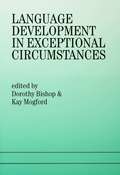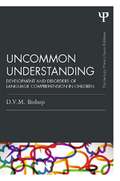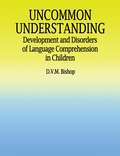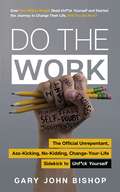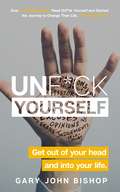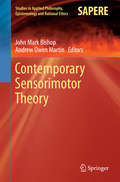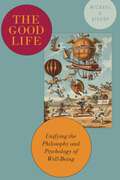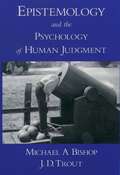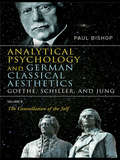- Table View
- List View
Obsessions: The Twisted Cruelty
by Francesco BisagniThis book explores the interrelatedness between obsessive compulsive disorders, thinking disorders, and depression. The issue is considered both from a psychiatric viewpoint and from a psychodynamic perspective. The age of the cases presented in the book ranges from childhood through adolescence to adulthood. Obsessions: The Twisted Cruelty is a challenging contribution to contemporary clinical debate, especially regarding the role of analytically-oriented psychotherapy in the treatment of OCD, and how to deal with the psychiatric treatment and combine the two approaches, while keeping the focus on the transference-countertransference interplay. After the first theoretical chapter, the relationship between obsessions and thinking impairments is discussed, with specific reference to delusional ideation. A section entitled "the anal conundrum" follows. Encopresis and anal masturbation during childhood are discussed, as well as the identification of the child with a maternal "faecal object. The last section explores the connection with depression, and some specific features of sadism.
Nonverbal Perceptual and Cognitive Processes in Children With Language Disorders: Toward A New Framework for Clinical intervention
by Walter Bischofberger F‚licie AffolterA growing body of literature is suggesting that many children with language disorders and delays--even those with so-called specific language impairment--have difficulties in other domains as well. In this pathbreaking book, the authors draw on more than 40 years of research and clinical observations of populations ranging from various groups of children to adults with brain damage to construct a comprehensive model for the development of the interrelated skills involved in language performance, and trace the crucial implications of this model for intervention. Early tactual feedback, they argue, is more critical for the perceptual/cognitive organization of experiences that constitutes a foundation for language development than either visual or auditory input, and the importance of tactually-anchored nonverbal interaction cannot be ignored if efforts at treatment are to be successful. All those professionally involved in work with children and adults with language problems will find the authors' model provocative and useful.
Nonverbal Perceptual and Cognitive Processes in Children With Language Disorders: Toward A New Framework for Clinical intervention
by Walter Bischofberger F‚licie AffolterA growing body of literature is suggesting that many children with language disorders and delays--even those with so-called specific language impairment--have difficulties in other domains as well. In this pathbreaking book, the authors draw on more than 40 years of research and clinical observations of populations ranging from various groups of children to adults with brain damage to construct a comprehensive model for the development of the interrelated skills involved in language performance, and trace the crucial implications of this model for intervention. Early tactual feedback, they argue, is more critical for the perceptual/cognitive organization of experiences that constitutes a foundation for language development than either visual or auditory input, and the importance of tactually-anchored nonverbal interaction cannot be ignored if efforts at treatment are to be successful. All those professionally involved in work with children and adults with language problems will find the authors' model provocative and useful.
Educational Planning of Court-Involved Youth: A Guide for Counties, Systems, and Individuals
by Amy BishopEducational Planning of Court-Involved Youth provides a framework for alleviating chronic barriers for youth in the child welfare and juvenile justice systems. This guide combines best-practice recommendations from national research with direct service tactics employed successfully in multiple counties. Included are the necessary components to implement a collaborative, community-centered intervention system that meets the needs of the county, family, and individual. With the understanding that each county carries its own strengths, barriers, and resources, these tools serve as a model for assessing and adapting the system to cater to the unique needs of each area in which it is implemented. This text helps facilitate the coordination and collaboration necessary to foster comprehensive systems and individualized planning for youth.
Educational Planning of Court-Involved Youth: A Guide for Counties, Systems, and Individuals
by Amy BishopEducational Planning of Court-Involved Youth provides a framework for alleviating chronic barriers for youth in the child welfare and juvenile justice systems. This guide combines best-practice recommendations from national research with direct service tactics employed successfully in multiple counties. Included are the necessary components to implement a collaborative, community-centered intervention system that meets the needs of the county, family, and individual. With the understanding that each county carries its own strengths, barriers, and resources, these tools serve as a model for assessing and adapting the system to cater to the unique needs of each area in which it is implemented. This text helps facilitate the coordination and collaboration necessary to foster comprehensive systems and individualized planning for youth.
Difference: An Avoided Topic in Practice
by Bernardine BishopDifference is a complex and often disturbing issue. The purpose of this book is to encourage a culture of open enquiry into an emotionally charged subject which, the editors argue, has been largely avoided by the profession. Theoretically psychoanalysis is all about recognition and appreciation of difference, yet the psychoanalytic profession itself does not have a good reputation in this area. This is a courageous collection of papers. All contributors have been prepared to go into print about situations in which difference is a significant element in their work and one around which they have felt uneasy and uncertain as they have found themselves in uncharted territory. Through painstaking analysis of their experience and that of their patients and clients, each contributor provides the reader with some useful insights and guidelines for future reference as well as some clear and stimulating illustrations of effective thinking in strange and disturbing situations. What makes this thinking effective is the demonstrated ability of all contributors to preserve their analytic functioning whatever the circumstances.
Difference: An Avoided Topic in Practice (The\lcp Practice In Psychotherapy Ser.)
by Bernardine BishopDifference is a complex and often disturbing issue. The purpose of this book is to encourage a culture of open enquiry into an emotionally charged subject which, the editors argue, has been largely avoided by the profession. Theoretically psychoanalysis is all about recognition and appreciation of difference, yet the psychoanalytic profession itself does not have a good reputation in this area. This is a courageous collection of papers. All contributors have been prepared to go into print about situations in which difference is a significant element in their work and one around which they have felt uneasy and uncertain as they have found themselves in uncharted territory. Through painstaking analysis of their experience and that of their patients and clients, each contributor provides the reader with some useful insights and guidelines for future reference as well as some clear and stimulating illustrations of effective thinking in strange and disturbing situations. What makes this thinking effective is the demonstrated ability of all contributors to preserve their analytic functioning whatever the circumstances.
Challenges to Practice (The\lcp Practice In Psychotherapy Ser.)
by Bernardine Bishop Angela Foster Josephine Klein Victoria O’ConnellThe first title in the Practice of Psychotherapy Series that explores the limits of psychoanalytic psychotherapy. Each of the five chapters in this book takes up an aspect of this challenge. In an open and enquiring manner, the authors invite readers to share in their thinking as they describe how they use their psychoanalytic skills to understand the nature of particular challenges. The Practice of Psychotherapy Series is intended to address a wide variety of important and challenging issues confronting those working in diverse contexts as psychoanalytic psychotherapists. Written by members of the respected London Centre for Psychotherapy, this volume offers an honest and stimulating first contribution.
Elusive Elements in Practice (The\lcp Practice In Psychotherapy Ser.)
by Bernardine Bishop Angela Foster Josephine Klein Victoria O'ConnellThe third volume in the The Practice of Psychotherapy series, Elusive Elements in Practice brings together a collection of papers, examining their ideas and theories more commonly regarded as off-centre, or indeed elusive, in psychoanalytic psychotherapy. The papers in this volume concentrate on the religious and spiritual dimension of the therapeutic encounter, the "aesthetic experience", creativity and mysticism. These "moments of relatedness", or meetings of minds, are discussed and examined with the help of clinical examples.'...psychotherapists tend to agree on what is just too eccentric and is to be regarded with reserve and suspicion. These ideas are left on the margins and, getting less attention, they are more elusive. They will not get concentrated consideration either in the consulting room or in the study. This is one reason why they are more elusive.
Ideas in Practice (The\lcp Practice In Psychotherapy Ser. #Vol. 2)
by Bernardine Bishop Angela Foster Josephine Klein Victoria O’ConnellComprising the second volume in the series The Practice of Psychotherapy, this volume brings together six contributors, all members of the London Centre for Psychotherapy, presenting psychoanalytic ideas lucidly illustrated by clinical observatioins taken from the consulting room. Focusing upon such issues as sibling attachment and the impact of maternal absence, this collection of essays offers uniquely personal insights and new idrom psychotherapeutic encounters. The author believes that in each of these papers there is the spark of an original idea...grounded indeed in psychoanalytic theory, but influenced by individual experience and observation in the consulting room.
Third International Handbook of Mathematics Education (Springer International Handbooks of Education #27)
by Christine Keitel, Jeremy Kilpatrick And Frederic Alan J. Bishop, Christine Keitel BishopThe four sections in this Third International Handbook are concerned with: (a) social, political and cultural dimensions in mathematics education; (b) mathematics education as a field of study; (c) technology in the mathematics curriculum; and (d) international perspectives on mathematics education. These themes are taken up by 84 internationally-recognized scholars, based in 26 different nations. Each of section is structured on the basis of past, present and future aspects. The first chapter in a section provides historical perspectives (“How did we get to where we are now?”); the middle chapters in a section analyze present-day key issues and themes (“Where are we now, and what recent events have been especially significant?”); and the final chapter in a section reflects on policy matters (“Where are we going, and what should we do?”). Readership: Teachers, mathematics educators, ed.policy makers, mathematicians, graduate students, undergraduate students. Large set of authoritative, international authors.
Pattern Recognition and Machine Learning (Information Science And Statistics Ser.)
by Christopher BishopThis is the first textbook on pattern recognition to present the Bayesian viewpoint. The book presents approximate inference algorithms that permit fast approximate answers in situations where exact answers are not feasible. It uses graphical models to describe probability distributions when no other books apply graphical models to machine learning. No previous knowledge of pattern recognition or machine learning concepts is assumed. Familiarity with multivariate calculus and basic linear algebra is required, and some experience in the use of probabilities would be helpful though not essential as the book includes a self-contained introduction to basic probability theory.
Language Development In Exceptional Circumstances
by Dorothy Bishop K. MogfordEver since attempts were made to describe and explain normal language development, references to exceptional circumstances have been made. Variations in the conditions under which language is acquired can be regarded as natural experiments, which would not be feasible or ethical under normal circumstances. This can throw light on such questions as: *What language input is necessary for the child to learn language? *What is the relationship between cognition and language? *How independent are different components of language function? *Are there critical periods for language development? *Can we specify necessary and sufficient conditions for language impairment? This book covers a range of exceptional circumstances including: extreme deprivation, twinship, visual and auditory impairments, autism and focal brain damage? Written in a jargon-free style, and including a glossary of linguistic and medical terminology, the book assumes little specialist knowledge. This text is suitable for both students and practitioners in the fields of psycholinguistics, developmental and educational psychology, speech pathology, paediatrics and special education.
Language Development In Exceptional Circumstances
by Dorothy Bishop Kay MogfordEver since attempts were made to describe and explain normal language development, references to exceptional circumstances have been made. Variations in the conditions under which language is acquired can be regarded as natural experiments, which would not be feasible or ethical under normal circumstances. This can throw light on such questions as: *What language input is necessary for the child to learn language? *What is the relationship between cognition and language? *How independent are different components of language function? *Are there critical periods for language development? *Can we specify necessary and sufficient conditions for language impairment? This book covers a range of exceptional circumstances including: extreme deprivation, twinship, visual and auditory impairments, autism and focal brain damage? Written in a jargon-free style, and including a glossary of linguistic and medical terminology, the book assumes little specialist knowledge. This text is suitable for both students and practitioners in the fields of psycholinguistics, developmental and educational psychology, speech pathology, paediatrics and special education.
Uncommon Understanding: Development and disorders of language comprehension in children (Psychology Press & Routledge Classic Editions)
by Dorothy V. BishopThis is a Classic Edition of Dorothy Bishop's award-winning textbook on the development of language comprehension, which has been in print since 1997, and now includes a new introduction from the author. The book won the British Psychological Society book award in 1999, and is now widely seen as a classic in the field of developmental language disorders. Uncommon Understanding provides a comprehensive account of the process of comprehension, from the reception of an acoustic signal, to the interpretation of communicative intentions, and integrates a vast field of research on language acquisition, psycholinguistics and neuropsychology. In the new introduction Dorothy Bishop reflects on the organization of the book, and developments in the field since the book was first published. A major theme in the book is that comprehension should not be viewed as a unitary skill – to understand spoken language one needs the ability to classify incoming speech sounds, to relate them to a "mental lexicon," to interpret the propositions encoded by word order and grammatical inflections, and to use information from the environmental and social context to grasp an intended meaning. Another important theme is that although neuropsychological and experimental research on adult comprehension provides useful concepts and methods for assessing comprehension, it should be applied with caution, because a sequential, bottom-up information processing model of comprehension is ill-suited to the developmental context. Although the main focus of the book is on research and theory, rather than practical matters of assessment and intervention, the theoretical framework presented in the book will continue to help clinicians develop a clearer understanding of what comprehension involves, and how different types of difficulty may be pin-pointed.
Uncommon Understanding: Development and disorders of language comprehension in children (Psychology Press & Routledge Classic Editions)
by Dorothy V. BishopThis is a Classic Edition of Dorothy Bishop's award-winning textbook on the development of language comprehension, which has been in print since 1997, and now includes a new introduction from the author. The book won the British Psychological Society book award in 1999, and is now widely seen as a classic in the field of developmental language disorders. Uncommon Understanding provides a comprehensive account of the process of comprehension, from the reception of an acoustic signal, to the interpretation of communicative intentions, and integrates a vast field of research on language acquisition, psycholinguistics and neuropsychology. In the new introduction Dorothy Bishop reflects on the organization of the book, and developments in the field since the book was first published. A major theme in the book is that comprehension should not be viewed as a unitary skill – to understand spoken language one needs the ability to classify incoming speech sounds, to relate them to a "mental lexicon," to interpret the propositions encoded by word order and grammatical inflections, and to use information from the environmental and social context to grasp an intended meaning. Another important theme is that although neuropsychological and experimental research on adult comprehension provides useful concepts and methods for assessing comprehension, it should be applied with caution, because a sequential, bottom-up information processing model of comprehension is ill-suited to the developmental context. Although the main focus of the book is on research and theory, rather than practical matters of assessment and intervention, the theoretical framework presented in the book will continue to help clinicians develop a clearer understanding of what comprehension involves, and how different types of difficulty may be pin-pointed.
Uncommon Understanding: Development and Disorders of Language Comprehension in Children
by Dorothy V.M. BishopA great deal has been written on how children learn to speak, but development of language comprehension has been a relatively neglected topic. This book is unique in integrating research in language acquisition, psycholinguistics and neuropsychology to give a comprehensive picture of the process we call "comprehension", right from the reception of an acoustic stimulus at the ear, up to the point where we interpret the message the speaker intended to convey by the utterance. A major theme of the book is that "comprehension" is not a unitary skill: to understand spoken language, one needs the ability to classify incoming speech sounds, to relate them to a "mental lexicon", to interpret the propositions encoded by word order and grammatical inflections, and to use information from the environmental and social context to select, from a wide range of possible interpretations, the one that was intended by the speaker. Furthermore, although neuropsychological and experimental research on adult comprehension can provide useful concepts and methods for assessing comprehension, they should be applied with caution, because a sequential, bottom-up information processing model of comprehension is ill-suited to the developmental context.The emphasis of the book is on children with specific language impairments, but normal development is also given extensive coverage. The focus is on research and theory, rather than practical matters of assessment and intervention. Nevertheless, while this book is not intended as a clinical guide to assessment, it does aim to provide a theoretical framework that can help clinicians develop a clearer understanding of what comprehension involves, and how different types of difficulty may be pinpointed.
Uncommon Understanding: Development and Disorders of Language Comprehension in Children
by Dorothy V.M. BishopA great deal has been written on how children learn to speak, but development of language comprehension has been a relatively neglected topic. This book is unique in integrating research in language acquisition, psycholinguistics and neuropsychology to give a comprehensive picture of the process we call "comprehension", right from the reception of an acoustic stimulus at the ear, up to the point where we interpret the message the speaker intended to convey by the utterance. A major theme of the book is that "comprehension" is not a unitary skill: to understand spoken language, one needs the ability to classify incoming speech sounds, to relate them to a "mental lexicon", to interpret the propositions encoded by word order and grammatical inflections, and to use information from the environmental and social context to select, from a wide range of possible interpretations, the one that was intended by the speaker. Furthermore, although neuropsychological and experimental research on adult comprehension can provide useful concepts and methods for assessing comprehension, they should be applied with caution, because a sequential, bottom-up information processing model of comprehension is ill-suited to the developmental context.The emphasis of the book is on children with specific language impairments, but normal development is also given extensive coverage. The focus is on research and theory, rather than practical matters of assessment and intervention. Nevertheless, while this book is not intended as a clinical guide to assessment, it does aim to provide a theoretical framework that can help clinicians develop a clearer understanding of what comprehension involves, and how different types of difficulty may be pinpointed.
Do the Work: The Official Unrepentant, Ass-Kicking, No-Kidding, Change-Your-Life Sidekick to Unf*ck Yourself (Unf*ck Yourself)
by Gary John BishopIf only you had more money, a different job, a bigger house, a passionate romance . . . your day-to-day would be a whole lot better, right? Blah de blah, blah, blah. Let Gary John Bishop dispel the bullsh*t you tell yourself and instead motivate you to design the life you want. This practical workbook expands the lessons in the international bestseller Unf*ck Yourself. It is a personal workshop for your brain, where you can determine what matters to you, empowering you to move forward without the emotional baggage. Broken down into three key pillars - self, people and purpose - you will answer Bishop's curated list of life-altering questions. These questions reveal what you have suppressed or tried to minimize, the kinds of thing one might throw into their metaphorical backpack and carry around until the weight becomes too much. By doing the work, you will understand your feelings and your actions like you never have before. The exercises allow you to stop the negative chatter, improve your relationships and give you the courage to instigate positive change. Do the Work is the nudge (or more like the kick in the ass) you need to get out of your rut.
Unf*ck Yourself: Get out of your head and into your life (Unf*ck Yourself)
by Gary John BishopTHE NEW YORK TIMES BESTSELLER!This is not the usual self-help book. Make your life one you actually want to live. This is blunt force trauma to the way you think life has to be for you. Most importantly, it is designed to give you an authentic leg up - one that feels genuine and right for you, and can propel you to new levels of greatness. Learn how to:Combat self-doubtDeal with your inner criticStop comparing yourself to othersBreak out of your rutIt will teach you not to look to the outside world for answers, but inside yourself. You will learn how to take full responsibility of your life, the highs and the lows, and you'll actually feel good about it - no, in fact, you'll feel f*cking great about it!
Contemporary Sensorimotor Theory (Studies in Applied Philosophy, Epistemology and Rational Ethics #15)
by John Mark Bishop Andrew Owen MartinThis book analyzes the philosophical foundations of sensorimotor theory and discusses the most recent applications of sensorimotor theory to human computer interaction, child’s play, virtual reality, robotics, and linguistics.Why does a circle look curved and not angular? Why does red not sound like a bell? Why, as I interact with the world, is there something it is like to be me? An analytic philosopher might suggest: ``if we ponder the concept of circle we find that it is the essence of a circle to be round’’. However, where does this definition come from? Was it set in stone by the Gods, in other words by divine arbiters of circleness, redness and consciousness? Particularly, with regard to visual consciousness, a first attempt to explain why our conscious experience of the world appears as it does has been attributed to Kevin O’Regan and Alva Noe, who published their sensorimotor account of vision and visual consciousness in 2001.Starting with a chapter by Kevin O’Regan, Contemporary Sensorimotor Theory continues by presenting fifteen additional essays on as many developments achieved in recent years in this field. It provides readers with a critical review of the sensorimotor theory and in so doing introduces them to a radically new enactive approach in cognitive science.
The Good Life: Unifying the Philosophy and Psychology of Well-Being
by Michael BishopPhilosophers defend theories of what well-being is but ignore what psychologists have learned about it, while psychologists learn about well-being but lack a theory of what it is. In The Good Life, Michael Bishop brings together these complementary investigations and proposes a powerful, new theory for understanding well-being. The network theory holds that to have well-being is to be "stuck" in a self-perpetuating cycle of positive emotions, attitudes, traits and accomplishments. For someone with well-being, these states -- states such as joy and contentment, optimism and adventurousness, extraversion and perseverance, strong relationships, professional success and good health -- build upon and foster each other. They form a kind of positive causal network (PCN), so that a person high in well-being finds herself in a positive cycle or "groove." A person with a lesser degree of well-being might possess only fragments of such a network -- some positive feelings, attitudes, traits or successes, but not enough to kick start a full-blown, self-perpetuating network. Although recent years have seen an explosion of psychological research into well-being, this discipline, often called Positive Psychology, has no consensus definition. The network theory provides a new framework for understanding Positive Psychology. When psychologists investigate correlations and causal connections among positive emotions, attitudes, traits, and accomplishments, they are studying the structure of PCNs. And when they identify states that establish, strengthen or extinguish PCNs, they are studying the dynamics of PCNs. Positive Psychology, then, is the study of the structure and dynamics of positive causal networks. The Good Life represents a new, inclusive approach to the study of well-being, an approach committed to the proposition that discovering the nature of well-being requires the knowledge and skills of both the philosopher in her armchair and the scientist in her lab. The resulting theory provides a powerful, unified foundation for future scientific and philosophical investigations into well-being and the good life.
Epistemology and the Psychology of Human Judgment
by Michael A Bishop J. D. TroutBishop and Trout here present a unique and provocative new approach to epistemology (the theory of human knowledge and reasoning). Their approach aims to liberate epistemology from the scholastic debates of standard analytic epistemology, and treat it as a branch of the philosophy of science. The approach is novel in its use of cost-benefit analysis to guide people facing real reasoning problems and in its framework for resolving normative disputes in psychology. Based on empirical data, Bishop and Trout show how people can improve their reasoning by relying on Statistical Prediction Rules (SPRs). They then develop and articulate the positive core of the book. Their view, Strategic Reliabilism, claims that epistemic excellence consists in the efficient allocation of cognitive resources to reliable reasoning strategies, applied to significant problems. The last third of the book develops the implications of this view for standard analytic epistemology; for resolving normative disputes in psychology; and for offering practical, concrete advice on how this theory can improve real people's reasoning. This is a truly distinctive and controversial work that spans many disciplines and will speak to an unusually diverse group, including people in epistemology, philosophy of science, decision theory, cognitive and clinical psychology, and ethics and public policy.
Analytical Psychology and German Classical Aesthetics: The Constellation of the Self
by Paul BishopThe second volume of Analytical Psychology and German Classical Aesthetics builds on the previous volume to show how German classicism, specifically the classical aesthetics associated with Goethe and Schiller known as Weimar classicism, was a major influence on psychoanalysis and analytical psychology alike. This volume examines such significant parallels between analytical psychology and Weimar classicism as the methodological similarities between Goethe’s morphological and Jung’s archetypal approaches, which both seek to use synthesis as well as analysis in their attempt to understand the world. It also focuses on the project of the construction of the self, which, it is argued, is not only a personal but also a cultural activity. This book, like its previous volume, aims to clarify the intellectual continuity between Weimar classicism and analytical psychology. It will be of interest to both students and scholars in the fields of analytical psychology, comparative literature, and the history of ideas.
Analytical Psychology and German Classical Aesthetics: The Constellation of the Self
by Paul BishopThe second volume of Analytical Psychology and German Classical Aesthetics builds on the previous volume to show how German classicism, specifically the classical aesthetics associated with Goethe and Schiller known as Weimar classicism, was a major influence on psychoanalysis and analytical psychology alike. This volume examines such significant parallels between analytical psychology and Weimar classicism as the methodological similarities between Goethe’s morphological and Jung’s archetypal approaches, which both seek to use synthesis as well as analysis in their attempt to understand the world. It also focuses on the project of the construction of the self, which, it is argued, is not only a personal but also a cultural activity. This book, like its previous volume, aims to clarify the intellectual continuity between Weimar classicism and analytical psychology. It will be of interest to both students and scholars in the fields of analytical psychology, comparative literature, and the history of ideas.
